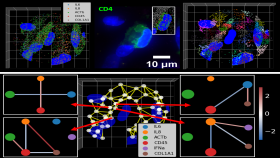Reporting in Nature Biotechnology, James Dahlman, assistant professor in the Department of Biomedical Engineering at Georgia Tech and Emory University, along with MIT graduate students Silvana Konermann and Omar Abudayyeh, and colleagues at MIT now show that guide RNAs can control the catalytic activity of Cas9. The authors demonstrate that rationally designed ‘deadRNAs’ can prevent active Cas9 from cutting, and instead, activate gene expression.
The CRISPR-Cas9 system genome editing platform has been used by labs across the world to specifically make changes to DNA. Wild type, active Cas9 protein is targeted to the correct DNA via a guide RNA sequence and then cuts the DNA target. Until recently, Cas9 catalytic activity has been controlled by mutating the protein so that it cannot cut DNA. These ‘deadCas9’ proteins bind DNA without cutting it, and have been fused to other proteins in order to fluorescently tag DNA or turn on gene expression.
A tool to selectively knock out and activate genes in the same cell (termed ‘orthogonal gene editing’) would provide a powerful method to manipulate biological processes, since most cellular functions are driven by combinations of genes. Inspired by the need for a simple orthogonal gene editing system, the MIT and Georgia Tech team designed a ‘deadRNA’ that functionally bound DNA without cutting it. deadRNAs were made by reducing the guide RNA target length to 14 or 15 bp, and by adding two MS2 binding loops into the sgRNA backbone. After systematically studying how the structure of deadRNAs influences gene activation and DNA cutting, and characterizing off-target gene activation, the authors knocked out and upregulated different genes in cells using a single active Cas9 protein.
The authors hope this technology will be useful for the field. ‘deadRNAs allow us to integrate two powerful functionalities of Cas9 – knocking out genes and activating them – in the same cell. This will be very useful for studying the interaction of different genes’, said Konermann, senior author of this study. Dahlman, the first author, agreed, noting that ‘deadRNAs may be useful for in vivo gene editing, since some mouse models already express active Cas9. My lab is excited to use deadRNAs to understand how complex gene interactions affect disease in cells and in animals’. The authors also highlighted that their work reveals an important concept. Previously, it was thought that active Cas9 could only be used to cut DNA. This work, as well as a similar study recently published by George Church’s laboratory at Harvard, demonstrate that guide RNAs can be designed to ‘functionally bind’ DNA without cutting it. Abudayyeh emphasized this point, noting that ‘our work and the exciting work from the Church lab, shows that the RNA encodes the functionality and can tell the protein whether to cut or not’. This points to a more fundamental mechanism, whereby the interactions between the protein, sgRNA, and DNA dictate whether the protein cuts the target DNA.
References
Dahlman JE, Abudayyeh OA, Joung J, Gootenberg JS, Zhang F, Konermann S. Orthogonal gene knock out and activation with a catalytically active Cas9 nuclease. Nature Biotechnology, 2015.
Kiani S, Chavez A, Tuttle M, Hall RN, Chari R, Beal J, Vora S, Buchthal J, Ebrahimkhani MR, Collins JJ, Weiss R, Church G. Cas9 gRNA engineering for genome editing, activation, and repression. Nature Methods, 2015.
James Dahlman, http://www.dahlmanlab.org/, assistant professor in the Department of Biomedical Engineering at Georgia Tech and Emory University, is a chemical and bioengineer whose work lies at the interface of nanotechnology, genomics, and gene editing. He studied in vivo gene editing at the Broad Institute; he received his Ph.D. from MIT and Harvard Medical School. There he designed nanoparticles that efficiently deliver RNAs to the lung and heart. These nanoparticles have been used by over ten labs across the United States to study disease. The Dahlman Lab is interested in drug delivery, targeted in vivo gene editing, and using genomics to understand and improve biomaterial design.
Silvana Konermann is a neuroscientist and bioengineer focused on developing better tools for the functional study of genetic disease. Silvana studied biology at ETH Zurich and is currently a Ph.D. candidate at MIT in the Department of Brain and Cognitive Science working in the lab of Feng Zhang. Her work has been focused on developing better technologies to study gene function, including tools for optical transcriptional and epigenetic perturbation as well as genome-scale transcriptional control using CRISPR/Cas9. She is interested in applying these tools to the high-throughput study of neurodegeneration. She has won the Harold M. Weintraub Award for her work.
CONTACT:
Walter Rich
Communications Manager
Wallace H. Coulter Department of Biomedical Engineering
Georgia Institute of Technology
Media Contact
Walter Rich
Communications Manager
Wallace H. Coulter Department of Biomedical Engineering
Georgia Institute of Technology
Keywords
Latest BME News
Courses in the Wallace H. Coulter Department of Biomedical Engineering are being reformatted to incorporate AI and machine learning so students are prepared for a data-driven biotech sector.
Influenced by her mother's journey in engineering, Sriya Surapaneni hopes to inspire other young women in the field.
Coulter BME Professor Earns Tenure, Eyes Future of Innovation in Health and Medicine
The grant will fund the development of cutting-edge technology that could detect colorectal cancer through a simple breath test
The surgical support device landed Coulter BME its 4th consecutive win for the College of Engineering competition.
New research from Georgia Tech helps doctors predict how therapies will interact with a child's immune system, potentially improving outcomes and reducing risks.
Georgia Tech researchers reveal the dynamic role of inhibitory neurons in spatial memory and learning








